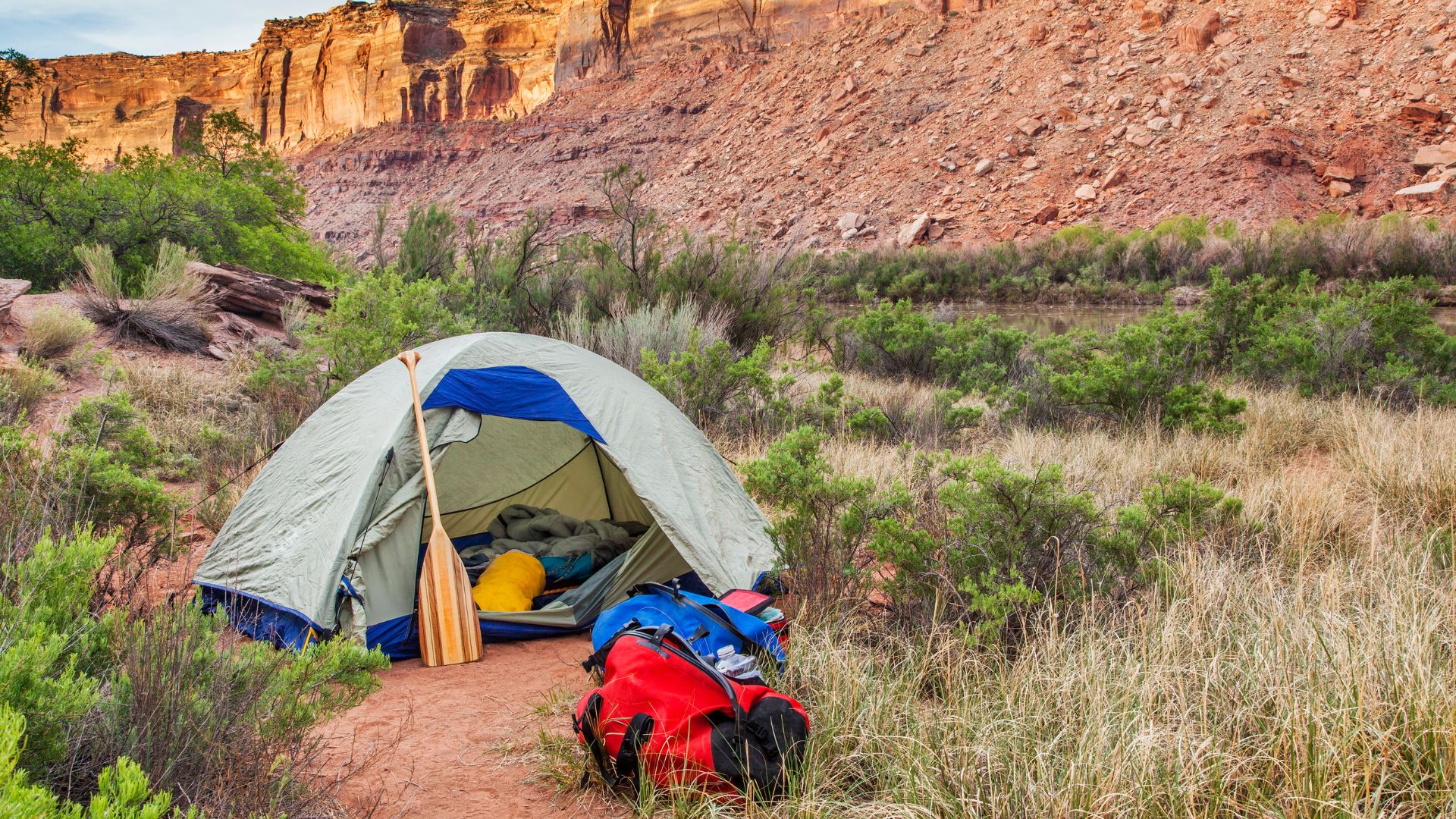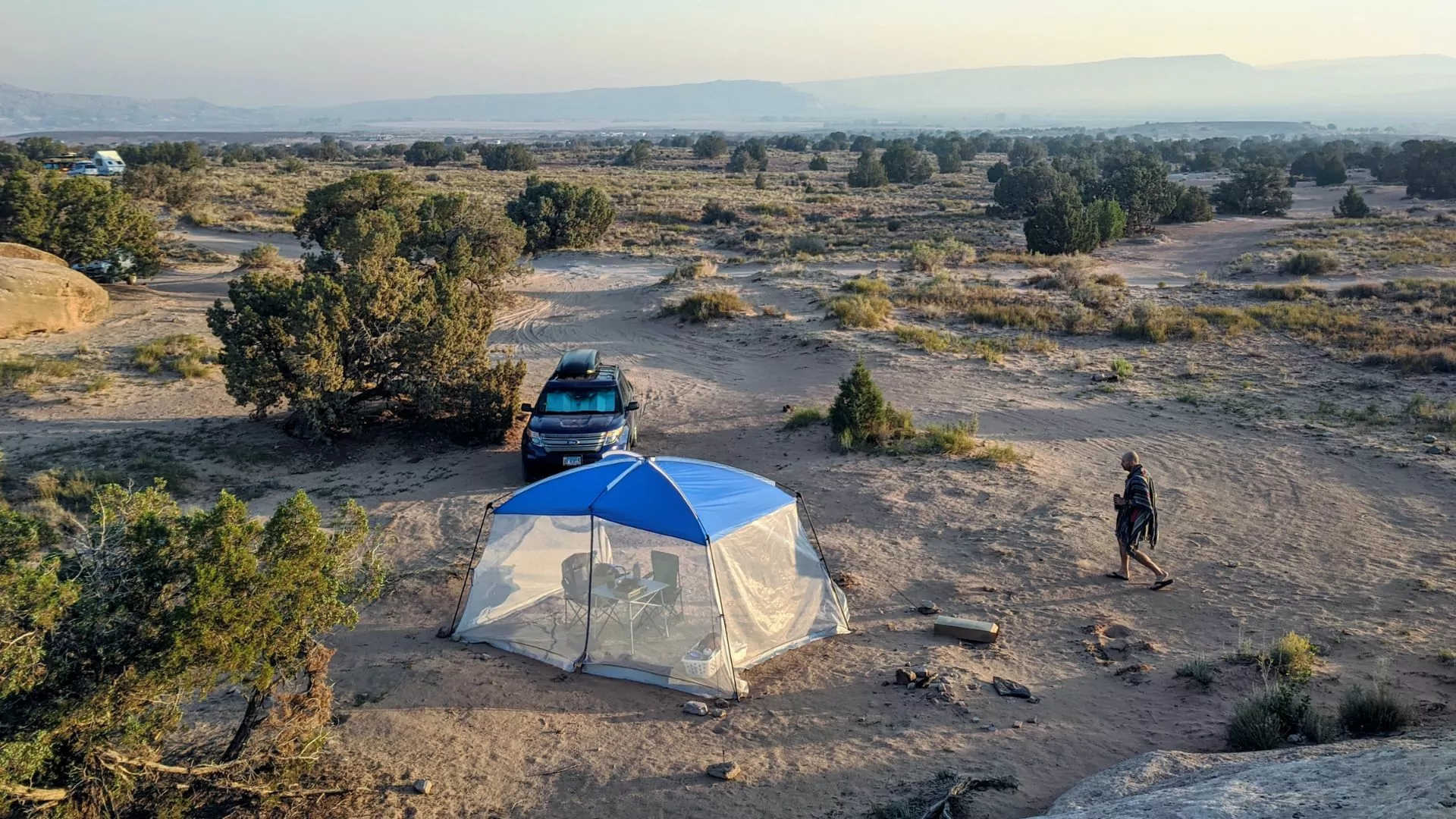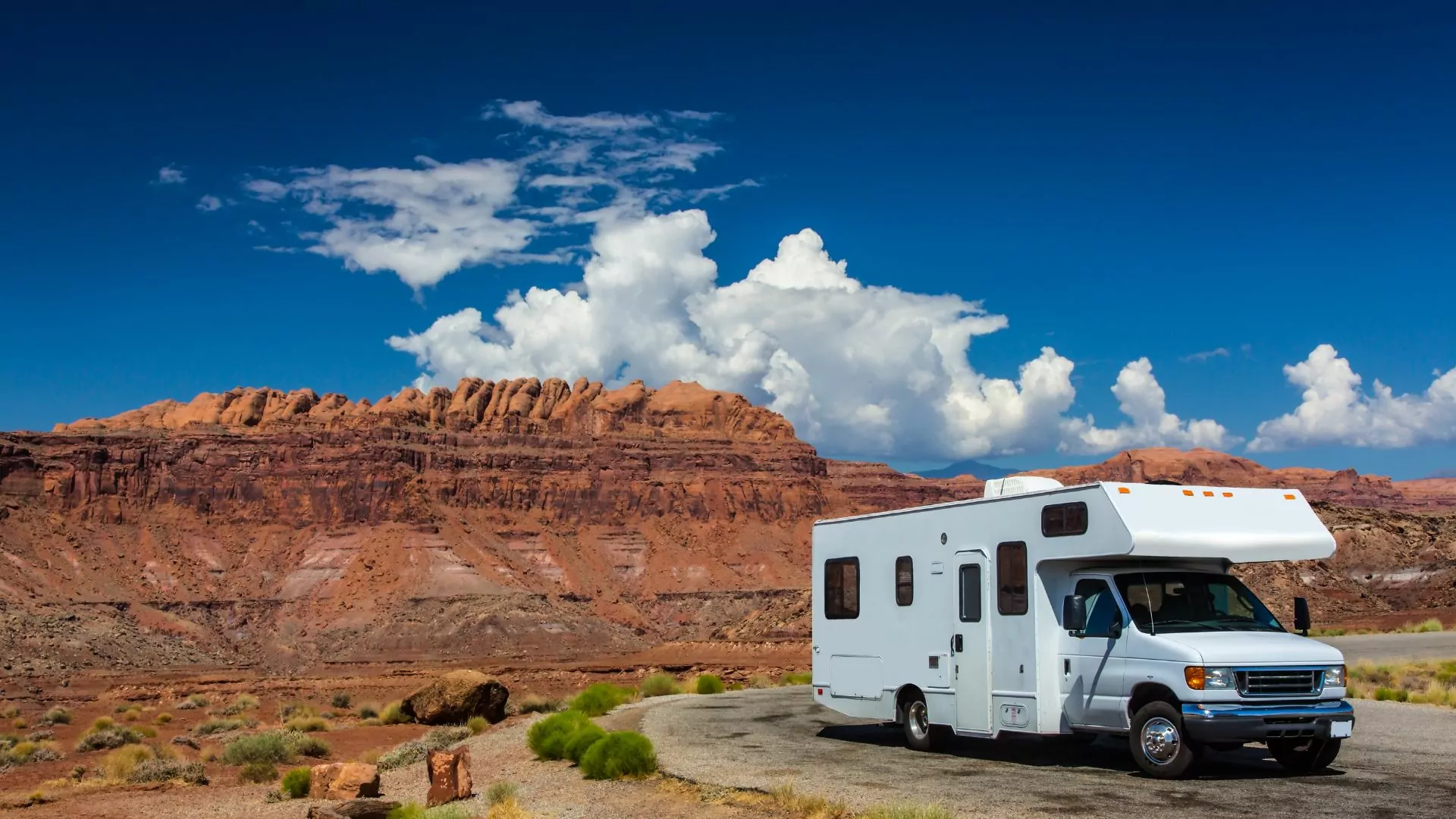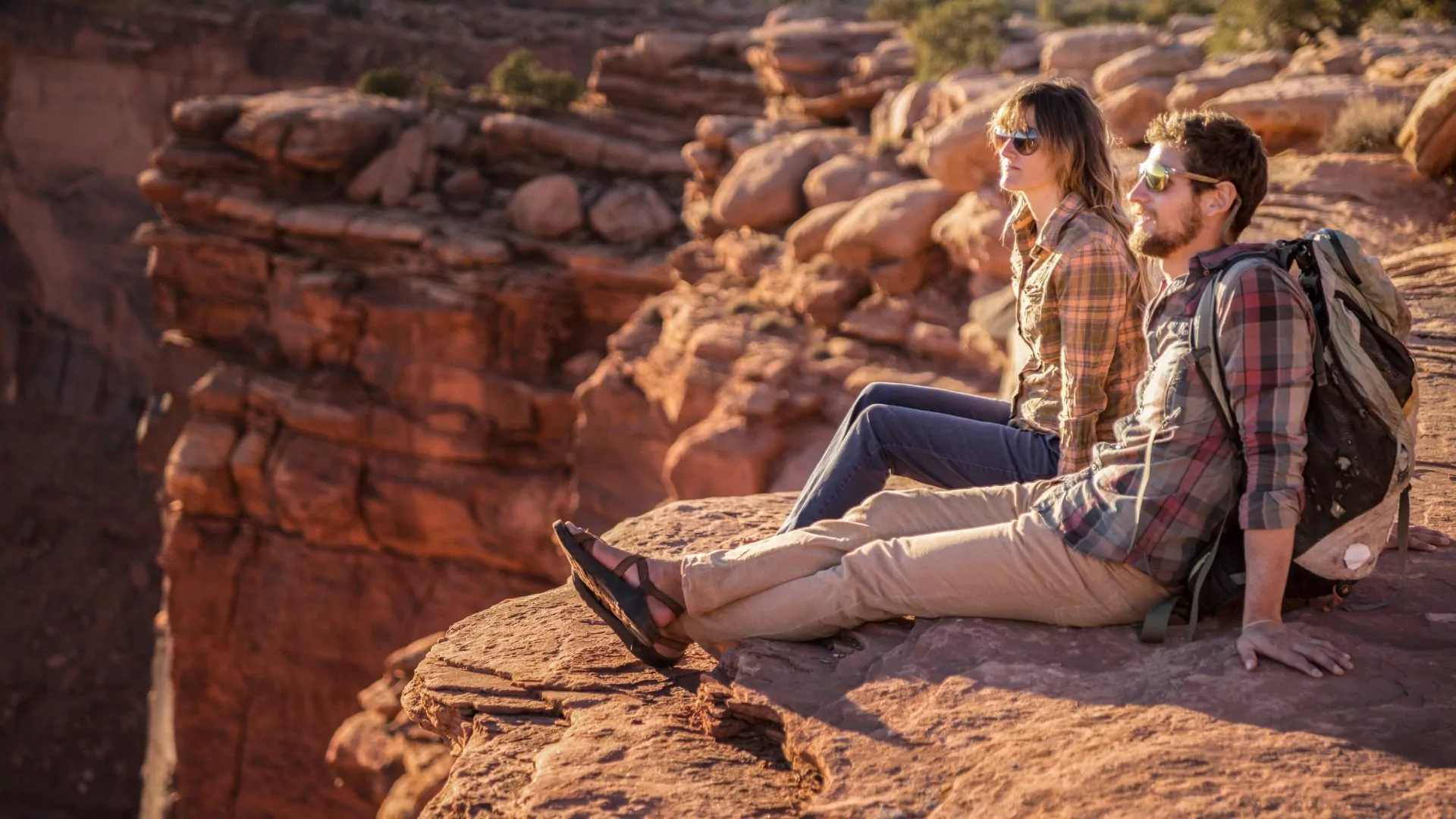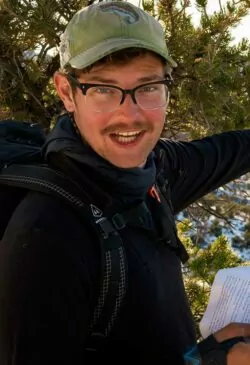Moab Utah Camping

Moab, Utah, is renowned for its stunning red rock landscapes, rugged desert terrain, and unparalleled access to outdoor recreation. All this adds up to make it a sought-after destination for camping enthusiasts from around the globe. Moab’s allure lies in its proximity to Arches and Canyonlands National Parks, boasting unique rock formations and extensive trails for exploration. Additionally, Moab’s surrounding BLM lands provide opportunities for dispersed camping and adventure activities.
If you’re reading this article, chances are you’ve already decided to get some sand in your sleeping bag and mud on your tires staying by staying in Moab. Now you are wondering, where do I stay?
In recent years, camping near Moab has become more complicated as the city has closed sites that were “overloved” by visitors, in order to protect and preserve the fragile desert environment. Changes made by the city of Moab and the BLM have resulted in the closure or restructuring of many long-standing dispersed campsites. While it may inconvenience some, prioritizing natural resources in these decisions is commendable. It’s essential for us all to play a part in better preserving these areas for future generations to enjoy.
This article provides a brief yet thorough guide to camping near Moab, including general recommendations and personal favorite spots. Whether you’re pitching a tent by the Colorado River, parking your RV beneath towering cliffs, or simply sleeping under the open sky, camping in Moab promises an unforgettable outdoor experience in one of Earth’s most awe-inspiring landscapes.
I’ll point out specific sites in and around Arches and Canyonlands National Parks, as well as areas north and south of Moab, providing clarity on camping options in this iconic destination.

Camping Considerations
While camping near Moab can be an adventure in and of itself, being prepared will help itinerant travelers keep these adventures out of the Type 3 Fun category.
- Gearheads Outdoor Store has a water fill up station, as well as any outdoor gear you could need before venturing out. Be sure to have ample water capacity while camping here, as the desert isn’t known for having excess water.
- City Market offers the best grocery selection for resupplying in town, but Moonflower Community Cooperative has more organic and health focused options
- Firewood can be purchased at the City Market gas station, and it typically has the cheapest gas in town (avoid the Chevron north of town if you don’t want to pay $0.40 a gallon more).
- Giliberto’s Mexican Taco Shop offers the best burritos in town and Milt’s has the best milkshakes.
- Almost every BLM campsite near Moab has a 14 day stay limit in a 30 day period. Luckily, there are enough sites around that as long as you move at least every other week you won’t have a problem following this rule.
Leave No Trace
The desert environment is full of exceptionally fragile flora and fauna that can take hundreds of years to grow. It is paramount that visitors tread lightly, staying on established trails and roads to avoid damaging cryptobiotic living soil crusts.
Cryptobiotic soil (crypto meaning “hidden” and “biota” meaning life) is a complex matrix of cyanobacteria, lichens, algae and fungus that help hold sand in place, preventing erosion and giving life a chance to grow.
Leave No Trace principles are especially important in this delicate ecosystem. In the desert environment, human waste is a serious issue. Use toilet facilities whenever you can. When these are not available, all solid waste, including toilet paper, must be packed out in WAG bags. WAG bags are specially made solid waste disposal bags that are strongly encouraged and sometimes required while recreating in a desert environment. Visitors can find WAG bags at gear shops in town and Visitor Centers in the National Parks. It is our collective responsibility to keep these areas clean and to provide sustainable outdoor recreation – do your part!
Appreciate wildlife and rock art from afar, and please refrain from touching either. Resist the urge to turn these delicate arches into your adult jungle gym, nature already undergoes significant transformation without our help. Consider future generations while camping near Moab, and help to preserve it.
Where to Camp
North of Moab

Devil’s Garden Campground, Arches National Park
Managed by: National Park Service | Tent or RV: Both |Cost: $25 per night
Note: They also have group sites if you’re trying to bring 11-55 of your closest friends ($75-$250)
Need to Know:
- March 1st to October 31st reservations are required through Rec.gov up to 6 months in advance for regular sites, 12 months in advance for group sites. Reservations open at 10am and are snatched up quickly.
- November 1st to April 31st sites are first come, first served
Situated at the end of the park’s main road, Devils Garden Campground offers 51 individual sites amidst stunning rock formations. Flushing toilets, trash cans, and sinks for washing dishes are the only amenities found in this primitive camp, but what it lacks in amenities it more than makes up for with its immaculate views and easy access to adventure in Arches. Note that this is the only campground to be found inside of Arches National Park.
Backcountry Camping, Arches National Park
Managed By: National Park Service | Tent or RV: Tent |Cost: $7 person per night
Need to Know:
- Reservations available in person only at The Backcountry Permit Office (2282 SW Resource Blvd 84532) located two miles south of Moab. They can be made up to seven days in advance from the start of a trip.
Arches National Park offers several designated backcountry campsites dispersed throughout the park’s remote areas. Three within Courthouse Wash and one in Devil’s Garden. These sites provide a primitive camping experience, with no facilities or amenities, allowing campers to truly experience the desert wilderness. These sites are also not the most straightforward to get to and require backcountry navigation skills to find, along with limited water sources within the Park. Check in with the Backcountry Office and make sure you know your route.
Note: The Backcountry Permit Office is outside of the Park in Moab
Willow Springs Campground, Utah Raptor State Park
Managed by: Utah State Parks | Tent or RV: Both | $15 per night
Distance to National Parks:
Arches: 10 – 15 minutes
Canyonlands Island in the Sky: 45 minutes
Canyonlands Needles District: 1 hour & 40 minutes
Need to Know:
- Camp only in previously disturbed sites, do not build new fire rings
- Pit toilets available near most campsites
Willow Springs Campground, formerly known as Willow Springs BLM Road, was once a highly popular free dispersed camping spot on BLM land. However, in recent years, the state of Utah has reclassified this area as part of the Utah Raptor State Park (contender for the coolest state park name). The road is dotted with excellent campsites; simply pull off and park near a campfire ring.
While it offers expansive desert views, its main draw is its proximity to Moab and Arches National Park. Previously epitomizing the quintessential dispersed camping experience (free, no rules, no parents, no bedtimes) its popularity led to its “overloved” status, prompting the need for better management. The state has responded by adding trash receptacles and outhouses–a significant improvement–as well as a $15/night fee. It’s unclear how long this will remain a dispersed campground, we shall see as the state finishes building out the new State Park.
It’s crucial to remember this site’s transformation when utilizing others in this guide; mistreating public lands could result in more regulations. Respect the local area and adhere to Leave No Trace principles.
Fallen Peace Officer Trailhead
Managed by: Bureau of Land Management | Tent or RV: Both (more RV) | Cost: Free
Distance to National Parks:
Arches: 15 – 20 minutes
Canyonlands Island in the Sky: 40 minutes
Canyonlands Needles District: 1 hour 45 minutes
Need to Know:
- Can be quite busy, expect to be parked near other people
- Some road noise from the highway, but the talus slopes do a surprisingly good job of blocking the worst of it
- The turnoff can be quite sudden, make sure you don’t miss it
Situated approximately 20 minutes north of Moab, The Fallen Peace Officer’s Trailhead offers a straightforward, no-frills camping experience. The site features a spacious parking lot tucked behind sizable talus slopes east of Highway 191. While a few campfire rings dot the area, it’s largely a free-for-all; campers can park wherever space permits and wave hi to the neighbors. Ideal for those seeking a couple of nights of hassle-free camping or for those with large RVs, this spot promises simplicity and convenience in equal measure.
Hwy 128/279 Corridor
Managed by: Bureau of Land Management | Tent or RV: Both | Cost: $20 per night
Distance to National Parks:
Arches: 10 minutes to 1 hour
Canyonlands Island in the Sky: 40 minutes to 1.25 hours
Note: The closest campground to Arches and Canyonlands in this area is Goose Island Campground, the furthest drive is Dewey Bridge.
Need to Know:
- Exact cash or check accepted on site in pay envelopes at all sites, while some boast a Remote Off Grid Kiosk (ROK) solar powered fee collection kiosk
- Each site is limited to 10 people and two vehicles
- No collecting firewood on site, this can be easily purchased in Moab at the City Market gas station
Reservations required: None. First come, first served sites.
The Colorado River runs just north of Moab, snaking from the east and disappearing into the west with Highways 128 & 279 (aka Potash Road) following along its banks. To the east, Castle Valley boasts a picturesque landscape defined by the towering Fisher Towers, the La Sal Mountains, and the meandering Colorado River. To the west, Potash Road lets travelers hug the Colorado River on one side and massive sandstone cliffs on the other.
Following these two roads along the river’s course, adventurers encounter 15 BLM campgrounds scattered along the river’s banks, offering between 5 to 33 sites each. These sites provide essential amenities like vault toilets, picnic tables, and fire rings, easily accessible even with two-wheel-drive vehicles, catering to both van-living enthusiasts and tent campers.
Among my preferred camping spots in this region are the Fisher Towers Campground and Lower Onion Creek. Fisher Towers, with its limited five sites, demands an early arrival for securing a spot. Fortunately, it also serves as the trailhead for The Fisher Towers Trail, allowing for a leisurely afternoon hike amidst the gravity-defying sandstone monoliths, followed by a return in time to enjoy dinner and witness the mesmerizing sunset.
The city of Moab has made this handy BLM camping guide, letting visitors know exactly how many sites are available at any given campground, max RV size, and even if they are equestrian friendly. These campsites are found in the Highway 128 and 279 sections.
Best of Moab Hiking and Camping TOUR
Indian Creek
Managed by: BLM | Tent or RV: Both | Cost: $15 per night
Distance to National Parks:
Arches: 1 hour to 1 hour 30 minutes
Canyonlands Island in the Sky: Roughly 2 hours
Canyonlands Needles District: 10 – 30 minutes
Need to Know:
- Designated campsites
- OR follow BLM’s dispersed camping rules
- Three group sites (Indian Creek Falls, Superbowl Group, Creek Pasture Group) can be booked up to twelve months in advance. These fit up to 50 people and are $65/night
Indian Creek, situated about an hour and a half south of Moab just before the entrance to the Needles District of Canyonlands National Park, is a haven for outdoor enthusiasts, particularly rock climbers. Renowned for its unparalleled sandstone splitter cracks and breathtaking sandstone cliffs, this area boasts stunning sunsets and a uniquely beautiful landscape. While Indian Creek could easily warrant an entire article dedicated solely to camping and exploring there, we’ll provide a brief overview here.
Within Indian Creek, three BLM-run campgrounds— Hamburger Rock, Superbowl, and Creek Pasture —offer first-come, first-served sites at $15 per night. These campgrounds provide amenities such as campfire rings and pit toilets, making them ideal bases for exploring the surrounding area.
For those seeking a more adventurous camping experience, dispersed camping is permitted in Indian Creek, as it falls within the boundaries of Bears Ears National Monument. However, it’s essential to adhere to BLM’s Dispersed Camping Rules to protect the fragile desert environment.
If you find yourself spending an extended period in Indian Creek, take the opportunity to make friends with fellow adventurers and explore the area beyond the main road. Poke around a little, you never know what you’ll find…
Yellow Circle Road
Managed by: Bureau of Land Management | Tent or RV: Both | Cost: Free
Distance to National Parks:
Arches: 30 – 45 minutes
Canyonlands Island in the Sky: 1 hour
Canyonlands Needles District: 1 hour & 15 minutes
Need to Know:
- Make sure to drive far enough back to be on BLM land. Pay attention to signage indicating where camping is and is not allowed
- 2WD accessible, but can be quite muddy and potentially inaccessible to 2WD vehicles after heavy rain. Stick to main road if 2WD, it’s easy to end up on a 4×4 trail if you take any turn offs
- Can be quite busy, and is a popular hub for people looking to drive 4×4 trails. There may be loud engines rumbling around camp, especially in the sites closest to the road
Reservations required: None. Free true BLM camping
Approximately 15 minutes south of downtown, Yellow Circle Road offers convenient camping near Moab for those seeking proximity to town. Exiting Hwy 191, strike east and then south, following the main road behind the talus slopes east of the highway. The first lot on the left accommodates 2WD vehicles, suitable for larger RVs and offroading trailers, barring recent heavy rain. For those craving seclusion, venturing further back and up the hills reveals additional campsites along the road. However, use caution as the road gets rougher the deeper you go.
West of Moab
Lone Mesa Dispersed Camping
Managed by: Bureau of Land Management| Tent or RV: Both | Cost: Free
Distance to National Parks:
Arches: 30 minutes
Canyonlands Island in the Sky: 30 minutes
Canyonlands Needles District: 2 hours
Need to Know:
- Usually 2WD accessible, but the road can be quite rough, especially after heavy rain storms
- There is also a group campsite located between this area and the turn off the highway, this site must be booked in advance. There are bathrooms available at the group site
Renowned for its proximity to Canyonlands Island in the Sky District and its expansive sunset vistas, Lone Mesa Dispersed Camping stands out as a gem among BLM campsites. The key here is exploration; adventurers are encouraged to search for their ideal spot (be sure to use previously existing sites rather than creating new ones). While the road from the highway may present challenges with sand or mud, cautious navigation should allow 2WD vehicles or RVs to reach at least the first large lot. Those willing to venture further into the road system will discover additional campsites, albeit potentially encountering rougher terrain.
